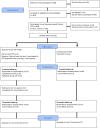Effects of a mindfulness-based and acceptance-based group programme followed by physical activity for patients with fibromyalgia: a randomised controlled trial
- PMID: 34187823
- PMCID: PMC8245472
- DOI: 10.1136/bmjopen-2020-046943
Effects of a mindfulness-based and acceptance-based group programme followed by physical activity for patients with fibromyalgia: a randomised controlled trial
Abstract
Introduction: Non-pharmacological approaches are recommended as first-line treatment for patients with fibromyalgia. This randomised controlled trial investigated the effects of a multicomponent rehabilitation programme for patients with recently diagnosed fibromyalgia in primary and secondary healthcare.
Methods: Patients with widespread pain ≥3 months were referred to rheumatologists for diagnostic clarification and assessment of study eligibility. Inclusion criteria were age 20-50 years, engaged in work or studies at present or during the past 2 years, and fibromyalgia diagnosed according to the American College of Rheumatology 2010 criteria. All eligible patients participated in a short patient education programme before inclusion and randomisation. The multicomponent programme, a 10-session mindfulness-based and acceptance-based group programme followed by 12 weeks of physical activity counselling was evaluated in comparison with treatment as usual, that is, no treatment or any other treatment of their choice. The primary outcome was the Patient Global Impression of Change (PGIC). Secondary outcomes were self-reported pain, fatigue, sleep quality, psychological distress, physical activity, health-related quality of life and work ability at 12-month follow-up.
Results: In total, 170 patients were randomised, 1:1, intervention:control. Overall, the multicomponent rehabilitation programme was not more effective than treatment as usual; 13% in the intervention group and 8% in the control group reported clinically relevant improvement in PGIC (p=0.28). No statistically significant between-group differences were found in any disease-related secondary outcomes. There were significant between-group differences in patient's tendency to be mindful (p=0.016) and perceived benefits of exercise (p=0.033) in favour of the intervention group.
Conclusions: A multicomponent rehabilitation programme combining patient education with a mindfulness-based and acceptance-based group programme followed by physical activity counselling was not more effective than patient education and treatment as usual for patients with recently diagnosed fibromyalgia at 12-month follow-up.
Trial registration number: BMC Registry (ISRCTN96836577).
Keywords: primary care; rehabilitation medicine; rheumatology.
© Author(s) (or their employer(s)) 2021. Re-use permitted under CC BY-NC. No commercial re-use. See rights and permissions. Published by BMJ.
Conflict of interest statement
Competing interests: None declared.
Figures
Similar articles
-
Effects of a community-based multicomponent rehabilitation programme for patients with fibromyalgia: protocol for a randomised controlled trial.BMJ Open. 2018 Jun 4;8(6):e021004. doi: 10.1136/bmjopen-2017-021004. BMJ Open. 2018. PMID: 29866731 Free PMC article.
-
Can mindfulness have long-term impact on patients with fibromyalgia? A two-year prospective follow-up study of a mindfulness-based intervention.Rheumatol Int. 2025 Jan 7;45(1):19. doi: 10.1007/s00296-024-05778-z. Rheumatol Int. 2025. PMID: 39775918 Free PMC article.
-
Effectiveness of a Multicomponent Treatment Based on Pain Neuroscience Education, Therapeutic Exercise, Cognitive Behavioral Therapy, and Mindfulness in Patients With Fibromyalgia (FIBROWALK Study): A Randomized Controlled Trial.Phys Ther. 2021 Dec 1;101(12):pzab200. doi: 10.1093/ptj/pzab200. Phys Ther. 2021. PMID: 34499174 Clinical Trial.
-
Mindfulness and bodily distress.Dan Med J. 2012 Nov;59(11):B4547. Dan Med J. 2012. PMID: 23171754 Review.
-
Mindfulness- and acceptance-based interventions for patients with fibromyalgia - A systematic review and meta-analyses.PLoS One. 2019 Sep 3;14(9):e0221897. doi: 10.1371/journal.pone.0221897. eCollection 2019. PLoS One. 2019. PMID: 31479478 Free PMC article.
Cited by
-
Optimal dose and type of exercise to reduce pain, anxiety and increase quality of life in patients with fibromyalgia. A systematic review with meta-analysis.Front Physiol. 2023 Apr 12;14:1170621. doi: 10.3389/fphys.2023.1170621. eCollection 2023. Front Physiol. 2023. PMID: 37123268 Free PMC article.
-
Effects of pharmacological and non-pharmacological interventions for the management of sleep problems in people with fibromyalgia: a multi-methods evidence synthesis.Health Technol Assess. 2025 May;29(20):1-228. doi: 10.3310/GTBR7561. Health Technol Assess. 2025. PMID: 40454897 Free PMC article.
-
Pain sensitization in fibromyalgia. Cross-sectional associations between quantitative sensory testing of pain sensitization and fibromyalgia disease burden.Eur J Pain. 2025 Jan;29(1):e4771. doi: 10.1002/ejp.4771. Eur J Pain. 2025. PMID: 39670546 Free PMC article.
-
Explaining a diagnosis of fibromyalgia in primary care: a scoping review.BJGP Open. 2023 Dec 19;7(4):BJGPO.2023.0033. doi: 10.3399/BJGPO.2023.0033. Print 2023 Dec. BJGP Open. 2023. PMID: 37468158 Free PMC article.
-
Are OMERACT recommendations followed in clinical trials on fibromyalgia? A systematic review of patient-reported outcomes and their measures.Qual Life Res. 2023 Jun;32(6):1521-1536. doi: 10.1007/s11136-022-03261-5. Epub 2022 Oct 1. Qual Life Res. 2023. PMID: 36181588 Free PMC article.
References
Publication types
MeSH terms
LinkOut - more resources
Full Text Sources
Medical
Miscellaneous


